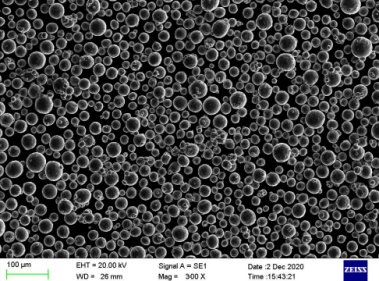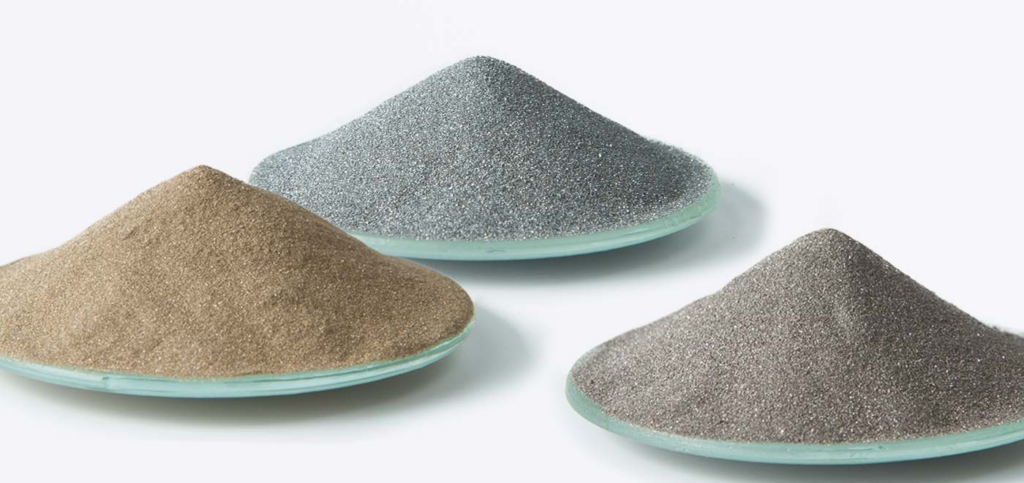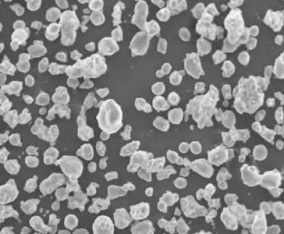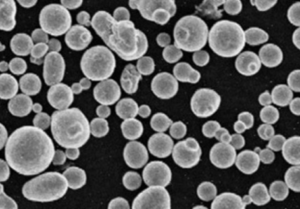Pós esféricos referem-se a materiais em pó com morfologia de partículas esféricas produzidas por processos de fabricação avançados. Este guia abrange as propriedades, os métodos de produção, as aplicações, as especificações, as vantagens e os fornecedores de pós esféricos em todos os setores.
Visão geral dos pós esféricos
Os pós esféricos contêm pequenas partículas de formato esférico que oferecem benefícios em relação aos formatos irregulares de pó:
- Melhor fluidez e densidade de empacotamento
- Redução dos vazios internos e da porosidade
- Distribuição uniforme do tamanho das partículas
- Acabamento mais suave nas peças sinterizadas finais
- Dispersibilidade mais fácil em fluidos
A morfologia esférica é vantajosa para pós metálicos usados em manufatura aditiva, metalurgia do pó, pulverização térmica, moldagem por injeção de metal e outras aplicações baseadas em pó.
Métodos de produção de pós esféricos
Os processos comuns para a fabricação de pós esféricos incluem:
- Atomização de gás - O jato de gás inerte de alta pressão derrete e desintegra o fluxo de metal em gotículas finas que se solidificam em pó esférico.
- Atomização por plasma - O metal é derretido usando uma tocha de plasma e atomizado por gás inerte em partículas esféricas.
- Fusão por indução de eletrodos - A barra de metal é derretida por indução e as forças centrífugas formam gotículas que se solidificam em um pó esférico.
- Métodos químicos - As reações de precipitação química controlada produzem partículas esféricas a partir de sais metálicos.
A atomização a gás com controle dos parâmetros do processo permite a obtenção consistente da distribuição desejada do tamanho do pó e da morfologia esférica. O processo de plasma permite a esfericidade de ligas reativas, como titânio e aluminetos de titânio.

Aplicações de pós esféricos
| Setor | Formulários |
|---|---|
| Manufatura aditiva | Impressão 3D de metais como aço inoxidável, titânio e ligas de níquel |
| Metalurgia do pó | Fabricação de peças P/M ferrosas e não ferrosas |
| Moldagem por injeção de metal | Produção de peças pequenas e complexas com bom desempenho |
| Spray térmico | Revestimentos resistentes ao desgaste e à corrosão |
| Eletrônicos | Pastas condutoras e filmes espessos |
| Cerâmica | Materiais precursores uniformes para cerâmica |
| Produtos farmacêuticos | Partículas de medicamentos com fluxo e dispersibilidade aprimorados |
Benefícios da morfologia esférica:
- Densidades de empacotamento mais altas para peças de P/M sinterizadas
- Menor rugosidade da superfície dos componentes acabados
- Redução da porosidade na manufatura aditiva
- Fluidez aprimorada para moldagem por injeção
- Espessura e cobertura uniformes para revestimentos de spray térmico
Especificações de pós esféricos
Os pós esféricos são caracterizados por parâmetros como:
| Parâmetro | Valores típicos |
|---|---|
| Materiais | Metais, ligas, cerâmicas, compostos |
| Tamanho da partícula | 1 - 150 mícrons |
| Forma da partícula | Esfericidade > 0,9 |
| Distribuição de tamanho | Controlado com base no aplicativo |
| Taxa de fluxo | 25 - 35 s/50g |
| Densidade aparente | Até 60% de densidade teórica |
| Teor de óxido | < 300 ppm para metais reativos |
| Rugosidade da superfície | < 1,5 μm |
| Porosidade | < 5% para pó esférico vs. 20% para pó irregular |
Os pós são personalizados quanto à distribuição de tamanho, composição e método de aplicação.
Fornecedores de pós esféricos
Alguns dos principais fornecedores globais de pós esféricos incluem:
| Empresa | Materiais em Pó |
|---|---|
| Sandvik Osprey | Ligas de titânio, níquel e cobalto |
| TLS Technik | Titânio, aços para ferramentas, cobre |
| Höganäs | Ferro, aços inoxidáveis |
| Praxair | Titânio, tungstênio, tântalo |
| Aditivo Carpenter | Cobalto-cromo, Inconel, Aços inoxidáveis |
| Tecnologia LPW | Titânio, alumínio, magnésio |
Os fornecedores investem em atomização de gás e tecnologia de plasma para produzir pós esféricos de alta qualidade. São oferecidos serviços de personalização.
Benefícios do uso de pós esféricos
Algumas das principais vantagens do uso de pós esféricos:
- Melhoria da densidade e redução da porosidade em peças sinterizadas
- Permite geometrias complexas por meio de um melhor fluxo de pó na moldagem por injeção
- Menor rugosidade da superfície devido à redução do intertravamento das partículas
- Composição e microestrutura uniformes
- Maior variedade de tamanhos de partículas alcançáveis
- Aumento da capacidade de reciclagem e reutilização do pó
A morfologia esférica aumenta a capacidade de fabricação, as propriedades e o desempenho das aplicações baseadas em pó.
Desafios com pós esféricos
Alguns desafios associados aos pós esféricos:
- Altos custos de produção em comparação com o pó irregular atomizado a gás
- Capacidade limitada de produzir grandes volumes
- Restrito a faixas de tamanho de partículas menores
- É necessário um manuseio especial para evitar danos às partículas
- Risco de oxidação para materiais reativos sem atmosfera inerte
- Requer métodos avançados de caracterização e teste

Comparação de custos com pós irregulares
| Tipo de pó | Custo por kg |
|---|---|
| Liga de níquel irregular | $30-60 |
| Liga esférica de níquel | $45-90 |
| Liga de titânio irregular | $80-150 |
| Liga esférica de titânio | $120-220 |
Custo mais alto devido à fabricação especializada, mas as propriedades aprimoradas justificam o uso quando o desempenho é crítico.
perguntas frequentes
P: O que é a esfericidade do pó e como ela é medida?
R: A esfericidade indica o quanto a partícula está próxima de uma esfera perfeita. Ela é medida com o uso de software de análise de imagem e fatores quantitativos de forma.
P: Qual é a vantagem da esfericidade no pó metálico?
R: O pó esférico melhora a fluidez, a densidade de empacotamento, a microestrutura e as propriedades como resistência à tração e vida útil à fadiga em peças sinterizadas e AM.
P: Qual o tamanho dos pós esféricos que podem ser produzidos?
R: Os métodos avançados de atomização de gás podem produzir pós esféricos até a faixa de escala nanométrica de 1 a 100 nm. Mas os tamanhos médios geralmente estão acima de 10 mícrons.
P: Quais são os setores que mais usam pós esféricos?
R: A manufatura aditiva e a metalurgia do pó são os maiores consumidores de pós esféricos devido aos benefícios significativos oferecidos.
P: Quais são as limitações dos pós esféricos?
R: O alto custo, os menores volumes produzidos, os riscos de oxidação no manuseio e as faixas de tamanho limitadas restringem a aplicabilidade. O pó irregular continua sendo mais amplamente utilizado.
P: Como os pós esféricos e não esféricos são diferenciados?
R: Quantitativamente, usando fatores de forma medidos por software, como circularidade, arredondamento e proporção. Também são usados descritores de forma qualitativos, como esférico, irregular, dendrítico e pipoca.
P: Existem riscos à saúde associados aos pós esféricos?
R: Sim, existem riscos de inalação como em qualquer pó fino. Controles de engenharia, ventilação e EPI apropriados devem ser usados para o manuseio seguro.
Conclusão
Os pós esféricos oferecem vantagens significativas em relação aos pós irregulares para métodos de fabricação como manufatura aditiva de metal e moldagem por injeção. Este guia abordou os métodos de produção de pós esféricos, as principais aplicações em todos os setores, as especificações, os benefícios nas propriedades e no desempenho das peças, a comparação de custos e o cenário de fornecedores. O futuro parece promissor para o aumento da adoção de pós esféricos em aplicações críticas.

